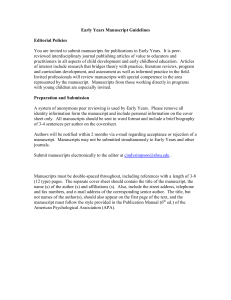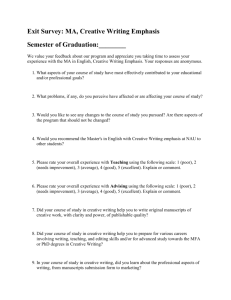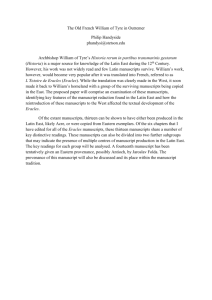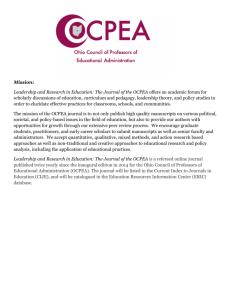MEMORY OF THE WORLD REGISTER
advertisement
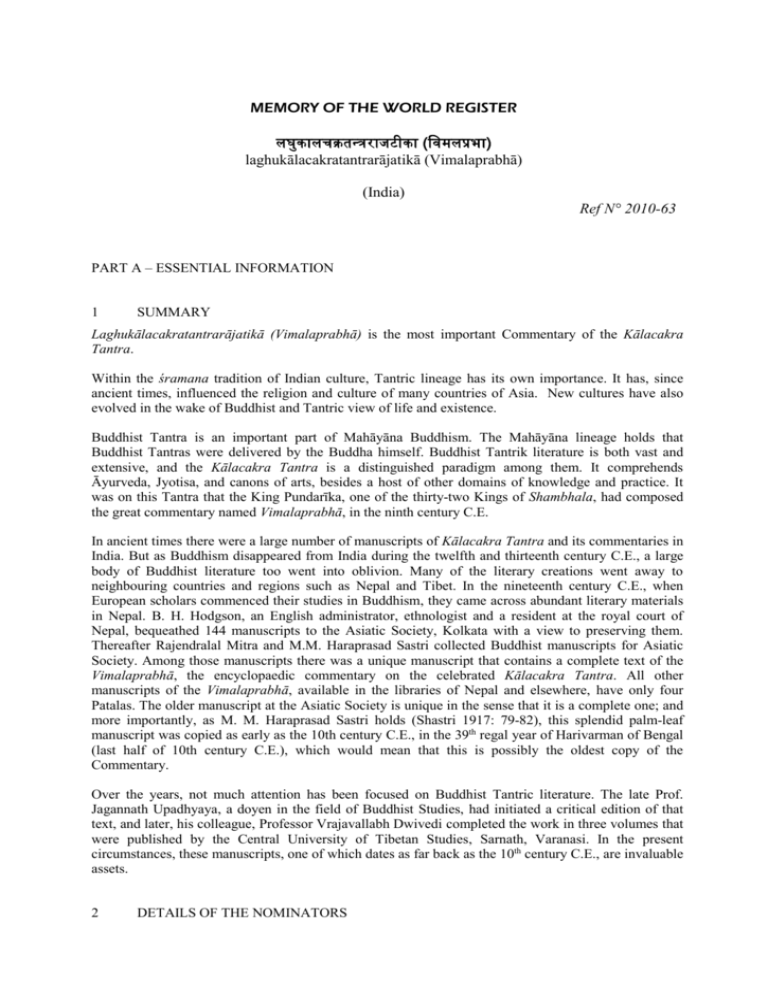
MEMORY OF THE WORLD REGISTER लघुकालचक्रतन्त्रराजटीका (विमलप्रभा) laghukālacakratantrarājatikā (Vimalaprabhā) (India) Ref N° 2010-63 PART A – ESSENTIAL INFORMATION 1 SUMMARY Laghukālacakratantrarājatikā (Vimalaprabhā) is the most important Commentary of the Kālacakra Tantra. Within the śramana tradition of Indian culture, Tantric lineage has its own importance. It has, since ancient times, influenced the religion and culture of many countries of Asia. New cultures have also evolved in the wake of Buddhist and Tantric view of life and existence. Buddhist Tantra is an important part of Mahāyāna Buddhism. The Mahāyāna lineage holds that Buddhist Tantras were delivered by the Buddha himself. Buddhist Tantrik literature is both vast and extensive, and the Kālacakra Tantra is a distinguished paradigm among them. It comprehends Āyurveda, Jyotisa, and canons of arts, besides a host of other domains of knowledge and practice. It was on this Tantra that the King Pundarīka, one of the thirty-two Kings of Shambhala, had composed the great commentary named Vimalaprabhā, in the ninth century C.E. In ancient times there were a large number of manuscripts of Kālacakra Tantra and its commentaries in India. But as Buddhism disappeared from India during the twelfth and thirteenth century C.E., a large body of Buddhist literature too went into oblivion. Many of the literary creations went away to neighbouring countries and regions such as Nepal and Tibet. In the nineteenth century C.E., when European scholars commenced their studies in Buddhism, they came across abundant literary materials in Nepal. B. H. Hodgson, an English administrator, ethnologist and a resident at the royal court of Nepal, bequeathed 144 manuscripts to the Asiatic Society, Kolkata with a view to preserving them. Thereafter Rajendralal Mitra and M.M. Haraprasad Sastri collected Buddhist manuscripts for Asiatic Society. Among those manuscripts there was a unique manuscript that contains a complete text of the Vimalaprabhā, the encyclopaedic commentary on the celebrated Kālacakra Tantra. All other manuscripts of the Vimalaprabhā, available in the libraries of Nepal and elsewhere, have only four Patalas. The older manuscript at the Asiatic Society is unique in the sense that it is a complete one; and more importantly, as M. M. Haraprasad Sastri holds (Shastri 1917: 79-82), this splendid palm-leaf manuscript was copied as early as the 10th century C.E., in the 39th regal year of Harivarman of Bengal (last half of 10th century C.E.), which would mean that this is possibly the oldest copy of the Commentary. Over the years, not much attention has been focused on Buddhist Tantric literature. The late Prof. Jagannath Upadhyaya, a doyen in the field of Buddhist Studies, had initiated a critical edition of that text, and later, his colleague, Professor Vrajavallabh Dwivedi completed the work in three volumes that were published by the Central University of Tibetan Studies, Sarnath, Varanasi. In the present circumstances, these manuscripts, one of which dates as far back as the 10th century C.E., are invaluable assets. 2 DETAILS OF THE NOMINATORS 2 2.1 Name (person or organisation) 1. Prof. Biswanath Banerjee (President) Asiatic Society 1 Park Street, Kolkata - 700 016 Cell: 9903039892 Phone No.: + 91 033 2229-0779, 2249-7250, 2229-7251 Fax No.: + 91 033 2217-2355 Email: aslibcal@cal.vsnl.net.in 2. Prof. Ramakanta Chakravarty (General Secretary) Asiatic Society 1 Park Street, Kolkata - 700 016 Cell: 9836577535 Phone No.: + 91 033 2229-0779, 2249-7250, 2229-7251 Fax No.: + 91 033 2217-2355 Email: aslibcal@cal.vsnl.net.in 3. Ms Roopa Srinivasan Director Ministry of Culture Room No 320-‘C’ Wing, Shastri Bhavan New Delhi India-110001 Phone: (0091) 011-23381822, Fax: (0091) 011-23381822 E-mail: railwayroopa@hotmail.com 4. Prof. Geshe Ngawang Samten (Vice Chancellor) Central University of Tibetan Studies Sarnath, Varanasi-221007 (U.P) INDIA Tel: +91 0542-2585242, Fax: +91 0542-2585150 Cell: 09839303558 Email: geshesamten@gmail.com 2.2 Relationship to the documentary heritage nominated 1 and 2. Prof. Biswanath Banerjee and Prof. Ramakanta Chakravarty are life members of the Asiatic Society and are presently holding the post of the President and the General Secretary of the Society, respectively. The Asiatic Society is the owner of the Manuscripts under reference. 3. Ms Roopa Srinivasan is the Director, looking after matters related to the Memory of the World Register, in the Ministry of Culture, Government of India. 4. Prof. Geshe Ngawang Samten is a renowned scholar of Tibetan Buddhist studies and presently holds the position of the Vice Chancellor of Central University of Tibetan Studies, Sarnath, Varanasi, an autonomous Institution under the Ministry of Culture, Government of India. The University has been undertaking editing, research, and publication of rare Buddhist texts. 3 2.3 Contact person (s) All the above are nominators. 2.4 Contact details (include address, phone, fax, email) 1. Prof. Biswanath Banerjee (President) Asiatic Society 1 Park Street, Kolkata - 700 016 Cell: 9903039892 Phone No.: + 91 033 2229-0779, 2249-7250, 2229-7251 Fax No.: + 91 033 2217-2355 Email: aslibcal@cal.vsnl.net.in 2. Prof. Ramakanta Chakravarty (General Secretary) Asiatic Society 1 Park Street, Kolkata - 700 016 Cell: 9836577535 Phone No.: + 91 033 2229-0779, 2249-7250, 2229-7251 Fax No.: + 91 033 2217-2355 Email: aslibcal@cal.vsnl.net.in 3. Ms Roopa Srinivasan Director Ministry of Culture Room No 320-‘C’ Wing, Shastri Bhavan New Delhi India-110001 Phone: (0091) 011-23381822, Fax: (0091) 011-23381822 E-mail: railwayroopa@hotmail.com 4. Prof. Geshe Ngawang Samten (Vice Chancellor) Central University of Tibetan Studies Sarnath, Varanasi-221007 (U.P) INDIA Tel: +91 0542-2585242, Fax: +91 0542-2585150 Cell: 09839303558 Email: geshesamten@gmail.com 3 IDENTITY AND DESCRIPTION OF THE DOCUMENTARY HERITAGE 3.1 Name and identification details of the items being nominated The chief features of the Collection may be summarized as follows: 1. Title: लघुकालचक्रतन्त्रराजटीका laghukālacakratantrarājatikā 1.1 Other Title: (विमलप्रभा) Vimalaprabhā 1.2 Manuscripts no: G-10766 and Manuscripts no: G-4727 in the collections of the Asiatic Society with its address at 1, Park Street, Kolkata - 700 016 (Phone No.: + 91 033 2229-0779, 2249-7250, 4 2229-7251Fax No.: + 91 033 2217-2355, Email: aslibcal@cal.vsnl.net.in). Manuscripts is the General Secretary, Asiatic Society, Kolkata. The custodian of the 2. Total Number of Manuscripts: 2 (two) manuscripts 3. Writing/Support Material: Both manuscripts are written on palm-leaf. 4. Script: Manuscript No. 10766 is in Gauḍī Bengali script of tenth century. This is a script of ancient Bengal in the Eastern part of India. Manuscript No- 4727 is in Newāri Script of 15th Century. Both manuscripts are in Sanskrit language. 5. Oldest Dated Manuscript: Manuscript No. G-10766 is of the tenth Century C.E. 6. Other Details: Manuscript No: G-10766 is a complete text; however folio numbers 2,3,5,6 and 11 are missing. It has a total number of 217 folios- and (F. 1 - 220 + 2 extra folios). Its physical size is: 56x5.5cm. Manuscript No: G-4727 has only 55 folios and it is incomplete. The size of the Manuscript is 47.5x5cm. These manuscripts are significant in terms of the texts’ historical, intellectual and aesthetic value. Tantra apart, the text contains detailed discussions of astrology and astronomy. There is also the lesser known and rare wisdom of svarodaya. Āyurveda occupies an important thematic focus in the Tantra. Many of Indian philosophical concepts are discussed in depth in this treatise. In the Lokadhātupatala measurements of the globe are given which are more detailed than those given in the Abhidharmakosa, a celebrated 4th Century text authored by Acharya Vasubandhu, which is itself a veritable encyclopaedia of information. The Abhishekakapatala delineates rules for construction of mandalas. Techniques of a variety of yantras-- a kind of technological mechanism--and devices for the building of castles are developed in the text. The importance of this manuscript is paramount also given the unfortunate turbulent situation in medieval India, where several Buddhist manuscripts were lost. 3.2 Description 3.2.1 Summary of the provenance: History of the Collection: The manuscripts were initially deposited at the Fort William College Library, Kolkata, (then Calcutta). On the abolition of the Fort William College, the entire collection of Sanskrit, Arabic, Persian and Urdu works, mostly in manuscript form, were placed in the custody of the Asiatic Society, in 18081. Considering the great value and cultural importance of this collection, Asiatic Society of Bengal, Calcutta, under the supervision of H. T. Colebrook (President) and Dr. W. Hunter (General Secretary), 1 Proceeding of the Asiatic Society, Volume -1 1784-1800, compiled and edited by Sibadas Chaudhuri, 1980, 46-48pp 5 took the responsibility of taking care of the manuscripts, by establishing a Resource Centre as well as a Manuscript Conservation Centre. Laghukālacakratantrarājatīkā (Vimalaprabhā) was part of the rare and important manuscripts included in this collection that were transferred from the College of Fort William to the Asiatic Society of Bengal, Kolkata in 1808. Both the manuscripts of Laghukālacakratantrarājatīkā (Vimalaprabhā) being proposed as nominations for inscription in the ‘Memory of the World Register’, are from the Government Collection of the Asiatic Society’s Holdings. card catalogue of manuscripts maintained by the Society’s library. The computerization of the card catalogue is also underway. The manuscripts have been microfilmed by the Asiatic Society, Kolkata in 1986 and 2008 (microfilm reel no. 86). Recently, the manuscript has also been scanned by Society with new A2 Faceup scanner in 2009 and scanned digitized copy is also available for readers. 4 Justification for inclusion/ assessment against criteria: Uniqueness and Significance: The Kālacakra Tantra was delivered by the Buddha at Dhānyakataka in South India. Later Tantric literature quotes from this Tantra in a profuse manner. The promulgator of this Tantra was Sucandra, the king of śambhala. It is said that the King Sucandra took the Tantra to his kingdom and helped its teaching to spread. This Tantra, discoursed by the Buddha and compiled by Sucandra was the Root Tantra text. It comprised 12000 ślokas. Currently the original Sanskrit text of the root Tantra is not available, except some passages from it are found quoted in other works. Mañjuśrīyaśas, the king in the lineage of "Kalkins", prepared an abridged version of the Tantra, which is known as the Laghukālacakratantra. Later, Pundariīka, his successor, composed a great commentary on the abridged version that is known as Vimalaprabhā. It was Siddha Cilupā who had made the Tantra current once again in Jambūdvīpa (India). He brought the lineage (tradition of the teaching and spiritual practices) of the Tantra from śambhala. As a result, during the eighth and ninth centuries C.E., studies, reflections and practices of the Tantra became widespread. An entire body of literature came up in the form of glosses and expositions on the teaching of the Tantra. Among the Buddhist Tantras the Kālacakra flowered magnificently in India leading to the spread of Buddhist culture. In the development and excellence of art in India, this Tantra played a vivifying role. It was later transmitted to Tibet, where it gained much importance. Tibetan scholars wrote learned treatises on various aspects of Tantric teachings. There are around 75 commentarial works and more than 600 other related works on the Kālacakratantra authored by Tibetan scholars. There are more than 30 commentaries on Vimalaprabhātīkā itself authored by Tibetan scholars. It cast a wide influence on the life and culture of the Tibetan people. Additionally, the Mahāyāna in Asia came under the influence of this Tantra. His Holiness the Dalai Lama has been giving initiations of this Tantra at home and abroad, and spreading its universal message far and wide. The Kālachakra Tantra is a work of an immense perspective. It is divided into five Patalas, namely, lokadhātupatala, ādhyātmapatala, abhisekapatala, Sādhanapatala, and jñānapatala. There is so much of enriching wisdom in these five Patalas, that it will not be an overstatement to say that the Tantra is an encyclopaedia in itself. Tantra apart, the text contains detailed discussions of astrology and astronomy. There is also the lesser known and rare wisdom of svarodaya. Āyurveda occupies an important thematic focus in the Tantra. Many of Indian philosophical concepts are discussed in depth in this treatise. In the Lokadhātupatala measurements of the globe are given which are more detailed than those given in the Abhidharmakosa, a celebrated 4th Century text authored by Acharya Vasubandhu, which is itself a veritable encyclopaedia of information. Techniques of a variety of yantras- a kind of technological mechanism--and devices for the building of castles are developed in the text. 6 This Tantra caught the attention of many learned persons. Nikolai Roerich, a well known Russian painter and scholar, based a number of his paintings on the teachings of the Kālacakra Tantra. The treatise is so enormous and deals with such a variety of subjects that its vastness stood in the way its publication. Professor Raghuvira and Lokesh Chandra published it in the śatapitaka series in 1966. The Asiatic Society published in 1985, a critical edition of this Tantra prepared by Professor Bisvanath Banerjee. The commentary Vimalaprabhā is found preserved in Nepal and other libraries of the world. On the basis of seven manuscripts of the commentary, the Central University of Tibetan Studies, Sarnath published the entire corpus in three volumes during the period 1986-1994. There are about 15 manuscripts of this commentary. Microfilms of the two manuscripts are available in collections of Professor Tucci, an eminent Italian scholar of Indology and Tibetology. There is at least one complete manuscript of Vimalaprabha that is said to have been preserved in Tibet. There are photographs of the two manuscripts in the famous Rahul Sankrityayan Collection in India. The Central University of Tibetan Studies has undertaken a project of publishing a revised edition of the Vimalaprabhā based on all the available manuscripts of this great commentary, along with a critical edition of the Tibetan translation available in four versions. Without a proper study of the Vimalaprabha, it is not possible for a scholar or a practitioner to have deeper access and insight into the Kalacakra Tantra. The Asiatic Society collection in Kolkata has the Vimalaprabhā, commentary on the Laghukālacakratantra on palm-leaf folios. These are unique and distinguished pieces. According to Professor M.M. Haraprasad Shastri, the oldest manuscript (G-10766) is dated to the last half of the 10th century C.E. It is written in the old Bengali script. In terms of the colophon, this manuscript was compiled on 29th of asadha in the 39th year of Harivarmadeva, the king of Bengal. R.C. Mazumdar fixed the date of the manuscript as belonging to 1119 C.E. From this it appears that, this copy of the manuscript was written a little over one hundred years after the commentary was composed. This would make it the oldest extant manuscript of the Vimalaprabhā. The Asiatic Society manuscript of Vimalaprabhā is thus both distinguished and unique, and is rightly a national treasure. 4.1 Is authenticity established? The manuscripts were collected by Sir William Jones and his associates and were deposited with the Fort William College Library, Kolkata. The manuscripts were transferred to The Asiatic Society, Kolkata in 1808 and are in the custody of the Asiatic Society, Kolkata, an autonomous Institution under the Ministry of Culture, Government of India. The quality of the palm-leaf and content clearly show that their authenticity cannot be doubted. It has not been doubted hitherto by any scholar who has handled and used them in their researches. 4.2 Is world significance, uniqueness and irreplaceability established? There is no doubt that Mahāyāna, with its two paths, namely, Pāramitāyāna and Tantrayāna had enjoyed a wide prevalence in India and exerted much influence on the life and culture of the country. Even though owing to esoteric nature of the teachings, the Tantra was not exposed to wider publicity, yet after the 7th century C.E. the teaching and practice of Tantra were exposed to wider audience and practitioners. Among the Tantras, the Kālacakratantra is a celebrated one, and the Vimalaprabhā, the commentary thereupon, is especially significant in view of the fact that it is a treatise complete in itself, and encapsulates a wide variety of themes and domains of learning, on account of which, it came to enjoy an influence which rejuvenated the life, spiritual practices and culture of the people of India. As against this backdrop, the manuscript Vimalaprabhā, the commentary of the Kālacakratantra, is a valuable treasure. Among the Manuscripts, the one numbered G. 10766 is complete. Other Manuscripts of this commentary, in libraries across the world are usually incomplete and do not go beyond the fourth patala. Another significant feature of the Manuscript is that it contains the final fifth patala along with a gloss thereupon. The Manuscript is taken to be of the 10th century C.E. and considered this way it could be taken as standing nearest to the original. 7 The tradition of copying of manuscripts is virtually extinct now. The Manuscripts of Vimalaprabhā represent beautiful specimens of old manuscripts from India and Nepal. The significance and irreplaceability of the MS is beyond any question. 4.3 Is one or more of the criteria of (a) time (b) place (c) people (d) subject and theme (e) form and style (f) social, spiritual and community significance satisfied? (a) Time: The manuscripts are in scripts of that time: G-10766 is written in Bengali (Gauḍī) script of Tenth Century and G- 4727, is in the Newari Script of the 15th Century. According to the colophon, the older manuscript was compiled on 29th of Asadha in the 39th year of Harivarmadeva, the king of Bengal. He is said to have reigned during the last half of the tenth century AD. R.C. Mazumdar fixed the date of the manuscript as belonging to 1119 C.E. According to Professor M.M. Haraprasad Shastri, the oldest manuscript (G-10766) is dated to the last half of the 10th century C.E. From this it appears that, this copy of the manuscript was written a little over one hundred years after the commentary was composed. This would make it the oldest extant manuscript of the Vimalaprabhā. The Asiatic Society manuscript of Vimalaprabhā is thus both distinguished and unique, and is rightly a national treasure. (b) Place: The older manuscript was probably written in Bengal, India. The second manuscript was probably written in Northeast India or present day Nepal. (c) People: There is no doubt that Mahāyāna, with its two paths, namely, Pāramitāyāna and Tantrayāna had enjoyed a wide prevalence in India and exerted much influence on the life and culture of the country. Even though owing to esoteric nature of the teachings, the Kālacakra tantra was not exposed to wider publicity, yet after the 7th century C., the teaching and practice of Tantra were exposed to wider audience and practitioners. Among the Tantras the Kālacakra tantra is a celebrated one, and the Vimalaprabhā, the commentary thereupon, is especially significant in view of the fact that it is a treatise complete in itself, and encapsulates a wide variety of themes and domains of learning, on account of which, it came to enjoy an influence which rejuvenated the life, spiritual practices and culture of the people of India. (d) Subject and Theme, and (e) Form and Style: These manuscripts are very important Buddhist Texts of Mahāyāna, especially Vajrayāna. This throws a flood of light on various areas of Buddhism which is an important branch of Mahāyāna tradition. From post colophon portion of the manuscript it is learnt that original Tantra was attributed to Paramādi Buddha. The commentator was Pundarika the son of Yaśa Kalki, a rājā of Kalāpa. This is a work of an immense perspective. It is divided into five Patalas, namely, lokadhātupatala, ādhyātmapatala, abhisekapatala, Sādhanapatala, and jñānapatala. There is so much of enriching wisdom in these five Patalas, that it will not be an overstatement to say that the work is an encyclopaedia in itself. Tantra apart, the text contains detailed discussions of astrology and astronomy. There is also the lesser known and rare wisdom of svarodaya. Āyurveda occupies an important thematic focus in this. Many of Indian philosophical concepts are discussed in depth in this treatise. In the Lokadhātupatala measurements of the globe are given which are more detailed than those given in the Abhidharmakosa, a celebrated 4th Century text authored by Acharya Vasubandhu, which is itself a veritable encyclopaedia of information. Techniques of a variety of yantras-- a kind of technological mechanism--and devices for the building of castles are developed in the text. Vimalaprabha, a commentary on the text of the Kālachakra Tantra, is a detailed exposition of the tenets of the Kālachakra Tantra, incorporating the various disciplines in the context of delineating the principles of the text. 8 As to the form and style the text is composed in good Sanskrit. Except for the first section, the narrative is mostly in prose, interspersed with Ślokas, quoted from various sources. Calligraphically this is has been commissioned with great care, demonstrating fine artistic expertise. 4.4 Are there issues of rarity, integrity, threat and management that relate to this nomination? 4.4.1 Rarity: The older manuscript is in Gauḍī Bengali script of tenth century and written on palm-leaf. R.C. Mazumdar fixed the date of the manuscript as belonging to 1119 C.E. From this it appears that, this copy of the manuscript was written about one hundred years after the commentary was composed. This would make it the oldest extant manuscript of the Vimalaprabhā. The Asiatic Society manuscript of Vimalaprabhā is thus both distinguished and unique, and is rightly a national treasure. Both the texts, particularly the older manuscript are the only manuscripts that can be traced back to such antiquity. 4.4.2 Integrity: The older manuscript in the collection (G-10766) is a complete text, which is a rare phenomenon. 4.4.3 Threat: The manuscript is susceptible to factors like aging and climatic changes. 4.4,4 Management: Although all care is taken at the Society to preserve these manuscripts, it is always necessary to take special steps for their conservation with latest devices and techniques. 5 LEGAL INFORMATION 5.1. Owner of the documentary heritage (name and contact details) 5.1. Owner of the Documentary Heritage (Name and Contact Details) The Asiatic Society Address: 1, Park Street, Kolkata - 700 016 Phone No.: + 91 033 2229-0779, 2249-7250, 2229-7251 Fax No.: + 91 033 2217-2355 Email: aslibcal@cal.vsnl.net.in 5.2 Custodian of the documentary heritage (name and contact details, if different to owner) On behalf of the Asiatic Society, the custodian of the Manuscripts is the General Secretary of the Asiatic Society. 5.3 Legal status: (a) Category of ownership The manuscripts are owned by the Asiatic Society, Kolkata, with its address as the Asiatic Society, 1Park Street, Kolkata - 700 016. 9 The Asiatic Society, Kolkata was established on 15th January 1784, by Sir William Jones (1746-1794). The name of the society has under gone various changes during the last two centuries, such as, The Asiatic Society of Bengal, 1832-1935, The Royal Asiatic Society of Bengal, 1936-1951, and in July 1952, it came to be known as the Asiatic Society. It is renowned all over the world for its very precious collection of Indian palm-leaf and other manuscripts. The Asiatic Society, Kolkata, is the oldest institution of learning of science and humanities of India today. “Some institutions reflect history and some have contributed to it.” Asiatic Society of Bengal, Kolkata, has contributed both by the retrieving, restoring, preserving, and studying the ancient remains and thus revealing the country’s past. Through its work the Society has revealed the cultural and intellectual achievement of India to the rest of the world. The manuscript collection of the Society’s library is both varied and rich. This vast collection of over 47,600 manuscripts is in as many as 26 scripts and covers most of the Indian scripts, languages and even several Asian ones, e.g., Assamese, Bengali, Gujrati, Gurumukhi, Kanarese, Urdu, Marathi, Nagari, Newāri, Oriya, Rajasthani, Sarada, Sinhalese, Armenian, Arabic, Persian, Javanese, Turki, Burmese, Chinese, Siamese, Mongolian and Tibetan. The materials of the manuscripts are also varied - Palm, and Palmyra leaves, barks of different trees and papers of various grades. The richest assets of this 226 years old Institute are its priceless manuscripts: The scholars who played a vital role in procuring and preserving these manuscripts were Rajendralala Mitra (1824-1891) and Haraprasad Sastri (1853-1931). The manuscripts collected by them are large in number and have been carefully examined and catalogued for the last one hundred years. Due to the Society’s immense contribution and historic importance, the Government of India declared it as “an Institution of National Importance” by an Act of Parliament on the occasion of its bi-centenary, year 1984. The Society is an autonomous Institution under the Ministry of Culture, Government of India. (b) Accessibility The manuscripts are accessible on request for consultation during the office hours of the Society Library (Monday to Friday). With due formalities completed, photocopying, acquiring copies in microfilms, digital scanned copy are available for reader service. (c) Copyright status The authors of the work are long deceased. The copyright of the catalogues, the images etc., however, is vested in the Asiatic Society, 1-Park Street, Kolkata - 700 016 (d) Responsible administration Care is being taken to keep the manuscripts safe and to safeguard them from all possible factors that could contribute to their deterioration. The Honorary Secretary of The Asiatic Society is legally responsible for safe keeping of the manuscripts and making them available to students and scholars only under strict supervision of the Research Officer and his/her staff. 6 MANAGEMENT PLAN 6.1 Is there a management plan in existence for this documentary heritage? YES/NO While there is no separate management plan currently in existence specifically for this manuscript, it is part of the important manuscript collection of the Asiatic Society, Kolkata and is properly maintained by it with its available resources. Keeping in mind its great importance and value, certain measures has 10 been put in place to ensure its conservation. The Society has so far made the best attempts to preserve the manuscripts. It has been proposed that the latest technologies and preservation methods if there are will also be explored. It is also proposed that international experts in this field will also be consulted for further improvement of the preservation. The Manuscripts are stored in the Museum Section of Asiatic Society in second floor of the Main Building which is air conditioned. The temperature and humidity are well controlled by humidity controller machine. There is, thus, hardly any threat from insects and fungi. The Shelf in the cupboards in which the manuscripts are kept, is made of stainless steel and the manuscripts are stored in wooden boxes made of well-seasoned Burma Teak, specially designed according to the size of the manuscripts. The Manuscripts are wrapped in acid free Nepalese/Tibetan Handmade paper and red cotton cloth (Shalu) and tied tightly with cotton thread. Defective leaves are laminated using fine Lens tissue paper (UK) and Cellulose Acetate foil. The manuscripts have been assigned accession numbers and are arranged accordingly. Preventive Measures of Conservation Adopted: Preventive methods of conservation adopted. These include the maintaining of temperature & relative humidity by 24 hours air-conditioning system in the stack area. The manuscripts are regularly cleaned with a soft brush. Book-worm insects are controlled by fumigation of insect infested Palm-Leaf manuscripts in the fumigation chamber using Paradichlorobenzene as a fumigant and insect repellents like Naphthalene bricks are kept along-with the bundles. The Manuscripts bundles are wrapped with the acid free hand made papers and starch-free redsalu which are kept horizontally on the steel racks covered with acid-free hand-made paper. Surfacefeeder insects are controlled by spraying of "Pip" (Mineral turpentine & Pyrethrum extract 2%) insecticide in the stack area once in a month. The manuscripts have been laminated using fine Lens tissue paper (UK), and its handling is restricted. Curative Measures of Conservation have also been put in place. Curative treatments are undertaken as and when it is necessary for the survival of the manuscripts. These include the cleaning of the PalmLeaf manuscripts with a fine brush to remove dust and then a mixture of rectified spirit and lime water (in the ratio 3:2) is applied with a cotton swab along-with the fiber length on the both the sides of the leaves. Surface written texts are cleaned with Tri-chloroethane. Dry and brittle leaves, are made flexible by application of Citronella-Oil. To make the writing on the Tala Palm-Leaf distinct, graphite powder is added to the oil and spirit mixture according to shade of the leaves. Damaged leaves which have been broken at the edges and those with large holes are repaired with a plain Palm-Leaf according to the size of the broken portions and shapes of the lacuna in the leaf. The treated brittle & fragile Palm-Leaf Manuscript sheets are strengthened by Chiffon-Lamination. The conservation of the Asiatic Society’s Museum is part of its Annual Plan. During the period from January to December 2009, the stack area of the Library has been treated with insecticidal chemicals. The Asiatic Society has over 220 employees with an annual budget of Rs10.5 crore, a significant proportion of both of which are devoted to the conservation and preservation of its vast manuscript collection. The manuscripts can be referred to through the card catalogue of manuscripts maintained by the Society’s library. The computerization of the card catalogue is also underway. The manuscripts have been microfilmed by the Asiatic Society, Kolkata in 1986 and 2008 (microfilm reel no. 86). Recently, the manuscript has also been scanned by Society with new A2 Face up scanner in 2009 and scanned digitized copy is also available for readers. Current Storage and Custody: The manuscripts are in the custody of the General Secretary of The Asiatic Society and are stored in the Manuscripts Section of the Library which is air conditioned. 11 All of them are shelved and stored in stainless steel storage. Manuscripts are wrapped with Nepalese/Tibetan handmade paper and red shalu cloths. Each manuscript has size-wise specially made separate cardboards of well-seasoned Burma teakwood box. Each folio of the rare palm-leaf manuscript is separated with tissue paper and the manuscripts had been laminated using fine Lens tissue paper (UK) and Cellulose Acetate foil. Cleaning and insecticidal treatment are regularly carried out. The humid climate of Kolkata is not so favourable and encourages growth of fungus and insects. The manuscripts are usually free from both these factors of deterioration. Curative treatments are carried out as deemed necessary. 7 7.1 CONSULTATION Provide details of consultation about this nomination with (a) the owner of the heritage (b) the custodian (c) your national or regional Memory of the World committee The owner of the heritage is the Asiatic Society, Kolkata. The custodian of the manuscripts on behalf of the Asiatic Society is the General Secretary of the Society. The authorities of the Society have been approached and consulted. They have consented to have the manuscript nominated. PART B – SUBSIDIARY INFORMATION 8 ASSESSMENT OF RISK 8.1 Detail the nature and scope of threats to this documentary heritage While the manuscripts are well preserved under the care of The Asiatic Society, the age of the manuscripts make them susceptible to deterioration. The humid climate of Kolkata is not so favourable and encourages growth of fungus and insects. At present the manuscripts are free from both these factors of deterioration. 9 ASSESSMENT OF PRESERVATION 9.1 Detail the preservation context of the documentary heritage The manuscripts are given preventive conservation treatment regularly by way of dusting, cleaning and airing. They are kept in good climatic conditions and handling is limited as much as possible. The Asiatic Society has a separate Manuscript Conservation section to take care of the manuscript with necessary conservation treatment.
